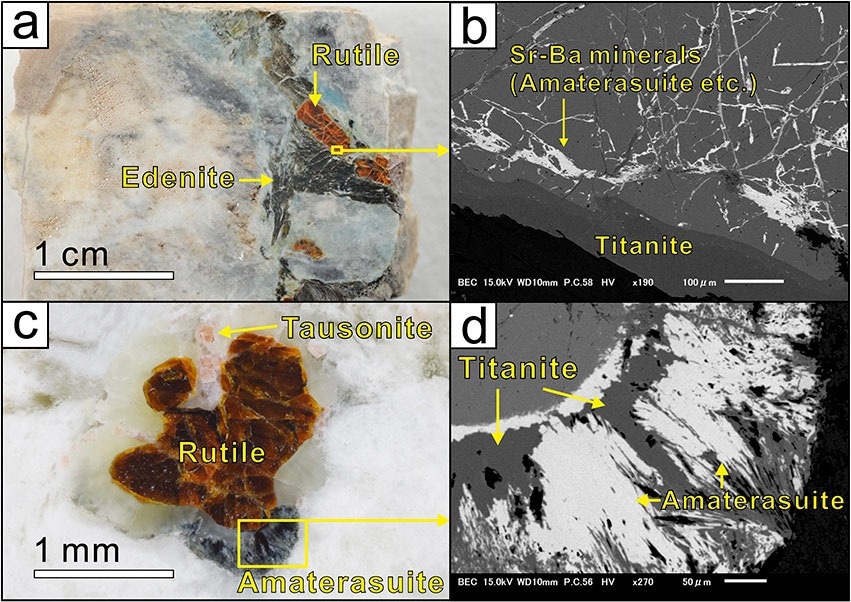Researchers have recently discovered Amaterasuite, a new mineral found in jadeitite, a rock with cultural and geological importance in Japanese society.

The representative occurrence of amaterasuite from jadeitite [(a) and (b)] and the metajadeitite area [(c) and (d)]. Amaterasuite often occurs by filling cracks in rutile in association with Sr-Ba minerals in jadeitite [(a) and (b)], whereas it occurs in titanite surrounding rutile in the metajadeitite area [(c) and (d)]. Image Credit: Nishio-Hamane, D. et al.
Amaterasuite’s unique composition and structure further researchers’ understanding of jadeitite formation and mineral diversity, highlighting the connection between geology and cultural heritage.
The mineral was named to honor Amaterasu Omikami, the sun goddess in Japanese mythology.
A recent study published in the Journal of Mineralogical and Petrological Sciences described its discovery, properties, and potential applications in mineralogy and petrology.
Importance of Jadeitite
Jadeitite, a nearly monomineralic rock composed of jadeite, has long been valued for its durability, beauty, and use in tools and ornaments since the Jomon period, about 7000 years ago.
In 2016, the Japan Association of Mineralogical Sciences officially designated it as the national stone. Its toughness and cultural significance highlight its importance.
Geologically, jadeitite forms particularly at divergent plate boundaries, where cold temperature gradients allow minerals to crystallize from aqueous fluids.
The complex tectonic history of the Japanese islands provides favorable conditions for its occurrence. Therefore, studying jadeitite and related minerals is crucial for understanding geological processes, the evolution of mineral resources, and the discovery of new mineral species.
What is Amaterasuite?
Researchers in the study identified and characterized Amaterasuite, a strontium (Sr)-rich mineral from the Osayama mountain area in Niimi City, Okayama Prefecture, Japan.
They collected a 1-meter jadeitite block from the boundary between serpentinite and rodingite within the Osayama mélange. In this rock, Amaterasuite occurs as needle- to plate-shaped aggregates up to 150 μm long, often filling fine cracks.
Several techniques were employed to determine its physical, chemical, and structural properties, including single-crystal and powder X-ray diffraction (XRD), Raman spectroscopy, electron diffraction, transmission electron microscopy (TEM) on ion-milled foils, and electron microprobe analysis (using standards such as Si and hematite).
Raman spectroscopy detected hydroxyl (OH) groups and vibrational modes, while XRD and TEM confirmed the orthorhombic Fddd space group.
Synchrotron powder XRD with Le Bail fitting, refined lattice parameters, and bond-valence calculations helped assign cation sites.
The Chemistry and Structure of Amaterasuite
Amaterasuite occurs in two environments within jadeitite and metajadeitite. Specifically, in jadeitite, it fills fine cracks in rutile. In metajadeitite, it is found in titanite surrounding rutile. This suggests that Amaterasuite may form through different geological processes and highlights its role as a common mineral in jadeitite.
Amaterasuite demonstrated a dual structural nature within a single unit cell, with occupancy rates of about 85% for Type A and 15% for Type B. This indicates a preference for Sr at specific sites, similar to trends seen in synthetic titanosilicates. These findings improve our understanding of mineral diversity in jadeitite and the tectonic history of the Osayama area.
The empirical formula of the new mineral was established as Sr4Ti6Si4O23(OH)Cl, indicating a complex arrangement of Sr, titanium (Ti), silicon (Si), oxygen (O), and chlorine (Cl). Physical properties included deep-blue to green pleochroism, a vitreous luster, a Mohs hardness of 6, a density of 4.0 g·cm-3, and a mean refractive index of 2.03. Raman spectroscopy confirmed the presence of hydroxyl groups, excluding molecular water.
Crystallographically, Amaterasuite is orthorhombic (space group Fddd) with unit-cell parameters a = 5.8603(3) Å, b = 20.4616(7) Å, c = 33.2810(12) Å, and a cell volume of approximately 3990.8 Å3 (Z = 8).
It was classified as a 4O polytype containing Type A and Type B motifs in a single unit cell. This dual structure, with a preference for Sr at the SrA site, highlights the complex nature of its formation within the titanate silicate framework.
Amaterasuite’s Potential in Mining and Material Science
The discovery of Amaterasuite has implications across mining and material science. It enhances our understanding of minerals in jadeitite and related rocks, which can inform exploration strategies and help discover other minerals. Their association with rutile and titanite provides indicators for micro-scale sampling and mapping in complex terrains.
In materials science, its unique properties, such as pleochroism, hardness, and polytype with distinct order-disorder behavior, may be useful for developing new gemstones, ceramics, catalysts, or other functional materials that replicate their structural diversity.
Understanding its formation and properties also helps mining and synthetic mineral research. Overall, Amaterasuite provides a foundation for further study and potential applications.
Conclusion and Future Directions in Mining
The identification of Amaterasuite marks a significant advancement in mineralogy, particularly in deepening our understanding of jadeitite and Japan’s geological history.
This discovery adds to the growing knowledge of mineral diversity and underscores the link between mineral formation and cultural context. It also lays the groundwork for further research into the properties, stability, and origins of Amaterasuite and related minerals.
Looking ahead, future studies could examine its potential applications across various fields, as well as its behavior under different geological conditions. These insights may even lead to the identification of new minerals within jadeitite and associated rock types.
Disclaimer: The views expressed here are those of the author expressed in their private capacity and do not necessarily represent the views of AZoM.com Limited T/A AZoNetwork the owner and operator of this website. This disclaimer forms part of the Terms and conditions of use of this website.
Source:
Nishio-Hamane, D. et al. (2025). Amaterasuite, Sr4Ti6Si4O23(OH)Cl, a new mineral from jadeitite, a representative stone of Japan. Journal of Mineralogical and Petrological Sciences, 250420 (120). https://doi.org/10.2465/jmps.250420